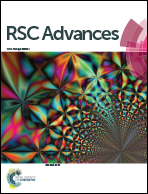Intein based bioprocess for production of a synthetic antimicrobial peptide: an alternative route to solid phase peptide synthesis†
Abstract
Despite increasing demands within the healthcare market, the growth of peptide based therapeutic products is challenged by the need for sustainable processing strategies using cheaper and eco-friendly processes. To overcome this hindrance, this study aims to evaluate the potential of the intein autocleavage based bioprocessing platform as an alternative to the solid phase peptide synthesis (SPPS) route for economical peptide manufacture. The robustness of the bioprocessing strategy was evaluated by designing a processing platform for manufacturing an 11-mer synthetic antimicrobial peptide. The peptide was successfully produced in its active form using the SspDnaB mini intein system and showed antimicrobial efficacy against E. coli, a common pathogen. The cleaved peptide and the cleavage reaction was further characterized by RP-HPLC, MALDI-TOF mass spectrometry and calorimetric methods. Process simulation studies were also conducted using the Super Pro Designer software to compare the overall process economics and environmental impact of the proposed bioprocessing strategy with the SPPS methodology. Operating costs for the intein based bioprocessing strategy was found to be at least two to three times cheaper compared to the SPPS method while being 5–8 times more environmentally friendly.


 Please wait while we load your content...
Please wait while we load your content...